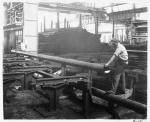![header=[Marker Text] body=[A block away was the plant in which Ralph C. Stiefel, the Swiss-born engineer, invented the rotary piercing process for making steel tubing, 1895. He helped found Ellwood Weldless Tube Co., which became a nucleus for National Tube Div. of U.S. Steel.] sign](kora/files/1/10/1-A-253-139-ExplorePAHistory-a0h7b4-a_450.jpg)
Mouse over for marker text
Name:
Seamless Tube Industry
Region:
Pittsburgh Region
County:
Lawrence
Marker Location:
PA 351, Lawrence Ave. at 7th St., Ellwood City
Dedication Date:
September 14, 1994
Behind the Marker
Tubes of iron or steel were nothing new in 1895. For 400 years cannon makers had been welding together bars of iron to form barrels for their weapons.  Riflemakers in colonial Pennsylvania had formed musket barrels in several skillful steps from a single long bar of iron. After heating the bar red-hot, they flattened it, hammered it around a forming rod or spandrel, and then welded the barrel's seam shut, again by heating and hammering.
Riflemakers in colonial Pennsylvania had formed musket barrels in several skillful steps from a single long bar of iron. After heating the bar red-hot, they flattened it, hammered it around a forming rod or spandrel, and then welded the barrel's seam shut, again by heating and hammering.
From the 1870s on, rolling mills could form precut sheets of iron or steel into tubes, which were again welded closed. But all these tubes had seams, and seams were where tubes inevitably split open.
During the great economic expansion of the late 1800s, Americans were using more tubes than ever before, for piping water, steam, natural gas, chemicals, and oil. It was the bicycle craze of the 1890s, however, that inspired Ralph Stiefel to invent a seamless tube.
In 1895 Stiefel installed the first seamless tube plant in Ellwood City, Pennsylvania, a city named for Isaac L. Ellwood, one of the inventors of the barbed wire that fenced in the West. Rather than start with flat sheets, Stiefel developed a process for piercing a hole straight through a cylinder of solid steel. If you imagine poking your finger through the center of a blob of dough to form a doughnut, you have the general idea of how Stiefel (and others) made seamless tubes. In time, Stiefel patented several of his inventions for rolling tubes.
A highly profitable concern, the Ellwood Weldless Tube Company was quickly caught up in the merger movement of the 1890s, reorganized as the Standard Seamless Tube Company, and then merged with sixteen tube makers in 1899 to create National Tube. The independent Shelby Steel Tube Company of Ohio, which made bicycle tubes using a British manufacturing design, was not among the National Tube companies in 1899, but it was included in the U.S. Steel merger two years later.
National Tube. The independent Shelby Steel Tube Company of Ohio, which made bicycle tubes using a British manufacturing design, was not among the National Tube companies in 1899, but it was included in the U.S. Steel merger two years later.
Tubes in their vast variety were among the numerous product lines that U.S. Steel dominated for years and that helped form an infrastructure of steel production in America.
From the 1870s on, rolling mills could form precut sheets of iron or steel into tubes, which were again welded closed. But all these tubes had seams, and seams were where tubes inevitably split open.
During the great economic expansion of the late 1800s, Americans were using more tubes than ever before, for piping water, steam, natural gas, chemicals, and oil. It was the bicycle craze of the 1890s, however, that inspired Ralph Stiefel to invent a seamless tube.
In 1895 Stiefel installed the first seamless tube plant in Ellwood City, Pennsylvania, a city named for Isaac L. Ellwood, one of the inventors of the barbed wire that fenced in the West. Rather than start with flat sheets, Stiefel developed a process for piercing a hole straight through a cylinder of solid steel. If you imagine poking your finger through the center of a blob of dough to form a doughnut, you have the general idea of how Stiefel (and others) made seamless tubes. In time, Stiefel patented several of his inventions for rolling tubes.
A highly profitable concern, the Ellwood Weldless Tube Company was quickly caught up in the merger movement of the 1890s, reorganized as the Standard Seamless Tube Company, and then merged with sixteen tube makers in 1899 to create
Tubes in their vast variety were among the numerous product lines that U.S. Steel dominated for years and that helped form an infrastructure of steel production in America.






